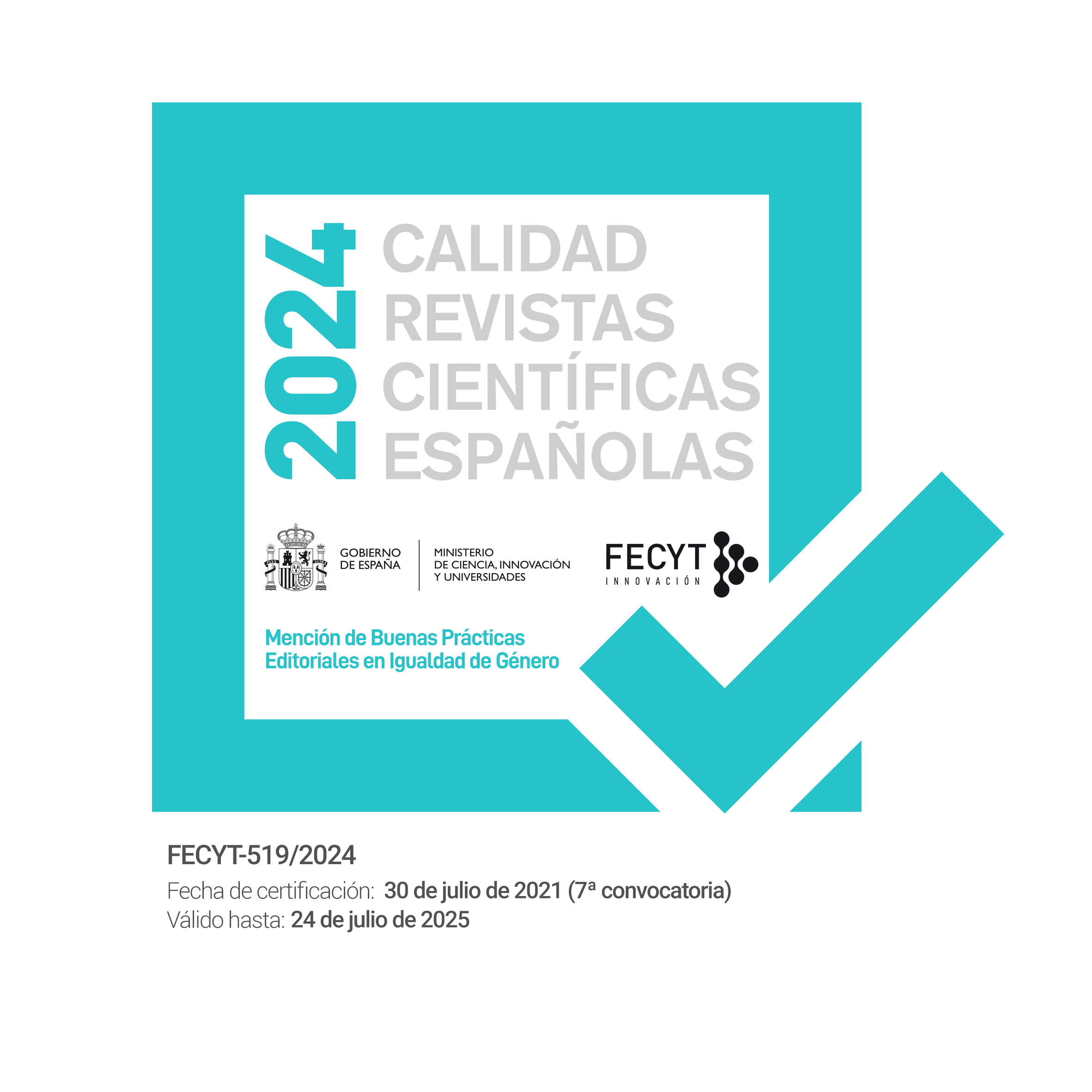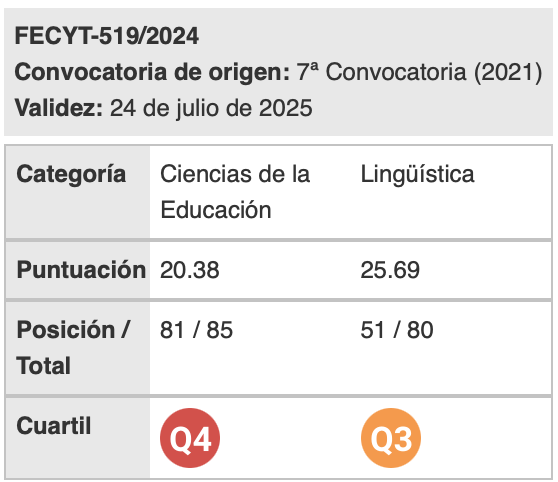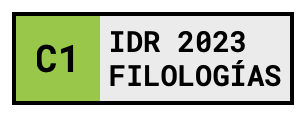Prosodic correlates of communication: boundary tone choice as an instruction for message interpretation from a multilevel linguistic perspective
Keywords:
Boundary tones, discourse, information status, politeness, relevanceAbstract
A phonetico-phonological study of Spanish declaratives which integrates the description of intonation tunes together with their pragmatic interpretations in the framework of a multilevel theory of communication is absent in most intonational accounts. In this paper, we contribute with a discourse-oriented analysis of read-news speech in Spanish. Its integrated two-fold orientation in terms of the universally well-accepted intonational framework, the Autosegmental-Metrical Theory, together with another universally recognised cognitive theory of communication, Relevance Theory, reveals that boundary tones stand as a powerful phonological unit to lead subjects through a structured discourse, and a contextualised presentation of information. In addition, our multilevel model of boundary tone interpretations also accounts for the socio-cultural use of politeness together with its orientation towards the different individuals in the communicative act: the speaker, the hearer, or both.
Downloads
References
Aguilar-Cuevas, L., Cabrera-Abreu, M., Estebas-Vilaplana, E., Gutiérrez-González, Y. & Vizcaíno-Ortega, F. (2013). Convenciones para el etiquetado prosódico en el marco Sp_ToBI del subcorpus de noticias de GLISSANDO. <http://glissando.upf.edu.> [21/10/2021]
Beckman, M., Díaz-Campos, M., McGory, J.T. & Morgan, T.A. (2002). Intonation across Spanish, in the Tones and Break Indices framework. Probus, 14, 9-36.
Boersma, P. & Weenink, D. (2021). Praat: doing phonetics by computer. [Computer program]. Version 6.1.55). <http://www.praat.org/> [11/10/2021]
Brown, P., & Levinson, S. C. (1987). Politeness: Some universals in language usage. Cambridge: Cambridge University Press.
Cruttenden, A. (1995). Rises in English. In Windsor Lewis, J. (Ed.), Studies in general and English phonetics. Essays in honour of Professor J.D. O'Connor (155-173). London: Routledge.
Dabrowski, A. & Labastía, L. (2013). Prosodia y relevancia en el discurso: selecciones tonales y altura tonal en el español rioplatense. In Labastía, L. (Ed.), Cuestiones de fonética, fonología y oralidad, Volúmenes temáticos de la Sociedad Argentina de Lingüística (71-88). Mendoza: Editorial de la Facultad de Filosofía y Letras de la Universidad Nacional de Cuyo. <http://ffyl.uncu.edu.ar> [10/09/2021]
Escandell-Vidal., M.V (1996). Introducción a la pragmática. Barcelona: Ariel.
Estebas-Vilaplana, E. & Prieto, P. (2008). La notación prosódica en español. Una revisión del Sp_ToBI. Estudios de Fonética Experimental, XVIII, 263-283.
Estebas-Vilaplana, E. & Prieto, P. (2010). Castilian Spanish. In Prieto, P. & Roseano, P. (Eds.), Transcription of intonation of the Spanish language. Munich: Lincom Europa.
Estebas-Vilaplana, E., Gutiérrez-Gonzalez, Y., Vizcaíno-Ortega, F. & Cabrera-Abreu, M. (2015). Boundary tones in Spanish declarative sentences modelling mid pitch. In The Scottish Consortium for ICPhS 2015 (Ed.), Proceedings of the 18th International Congress of Phonetic Sciences. Glasgow: University of Glasgow.
Fretheim, T. (2002). Intonation as a constraint on inferential processing. In Bernard, B. & Marlien, I. (Eds.), Proceedings of the First International Conference on Speech Prosody (307-310). Aix-en-Provence: ProSig et Université de Provence Laboratoire Parole et Language.
Garrido-Almiñana, J.M. et al. (2013). Glissando: a corpus for multidisciplinary prosodic studies in Spanish and Catalan. In Language resources and evaluation. DOI10.1007/s10579-012-9213-0.
Gutiérrez-González, Y. & Aguilar Cuevas, L. (2015). Nuevos datos empíricos sobre la entonación del español a partir del corpus de noticias Glissando. Estudios de fonética experimental, Vol. 24, 35-81.
House, J. (1990). Intonation structures and pragmatic interpretations. In Ramsaran, S. (Ed.), Studies in the pronunciation of English. A commemorative volume in honour of A.C. Gimson. London: Routledge.
House, J. (2006). Constructing a context with intonation. Journal of Pragmatics, 38(10), 1542-1558.
Labastía, L. (2011). Procedural encoding and tone choice in Buenos Aires Spanish. In Escandell-Vidal, M.V., Leonetti, M. & Ahern, A. (Eds.), Procedural meaning: problems and perspectives (383-413). Bingley: Emerald.
Ladd, R. (1996). Intonational phonology. Cambridge: Cambridge University Press.
López-Bobo, M. J. & Cuevas-Alonso, M. (2010). Cantabrian Spanish intonation. In Prieto, P. & Roseano, P. (Eds.), Transcription of intonation of the Spanish language. Munich: Lincom Europa.
Pierrehumbert, J. (1980). The phonetics and phonology of English intonation. PhD thesis. Massachusetts: Massachusetts Institute of Technology.
Prieto, P. (2014). The intonational phonology of Catalan. In Jun, S.A. (Ed.), Prosodic typology 2. The phonology of intonation and phrasing (43-80). Oxford: Oxford University Press.
Prieto, P. & Roseano, P. (Eds.) (2010). Transcription of intonation of the Spanish language. Munich: Lincom Europa.
Sosa, J.M. (1999). La entonación del español. Madrid: Cátedra.
Sperber, D. & Wilson, D. (1995). Relevance: communication and cognition. Oxford: Blackwell.
Vizcaíno-Ortega, F. & Cabrera-Abreu, M. (2012). Relevance and attribution in the intonation of Gran Canaria Spanish interrogatives. Journal of Pragmatics, 44(10), 1219–1239.
Wells, J.C. (2006). English intonation. An introduction. Cambridge: Cambridge University Press.
Wilson, D. & Sperber, D. (2004). Relevance theory. In Horn, L. & Ward, G. (Eds.), The handbook of pragmatics (607–632). Oxford: Blackwell.
Wilson, D. & Wharton, T. (2006). Relevance and prosody. Journal of Pragmatics, 38(10), 1559–1579.
Downloads
Published
How to Cite
Issue
Section
License
Authors who publish with this journal agree to the following terms:
- Authors retain copyright and grant the journal right of first publication with the work simultaneously licensed under a Creative Commons Attribution License that allows others to share the work with an acknowledgement of the work's authorship and initial publication in this journal.
- Authors are able to enter into separate, additional contractual arrangements for the non-exclusive distribution of the journal's published version of the work (e.g., post it to an institutional repository or publish it in a book), with an acknowledgement of its initial publication in this journal.
- Authors are permitted and encouraged to post their work online (e.g., in institutional repositories or on their website) prior to and during the submission process, as it can lead to productive exchanges, as well as earlier and greater citation of published work (See The Effect of Open Access).

Revista de Lenguas para fines específicos is licensed under a Creative Commons Reconocimiento-NoComercial-SinObraDerivada 4.0 Internacional License.

























